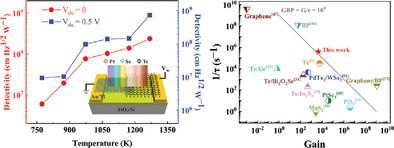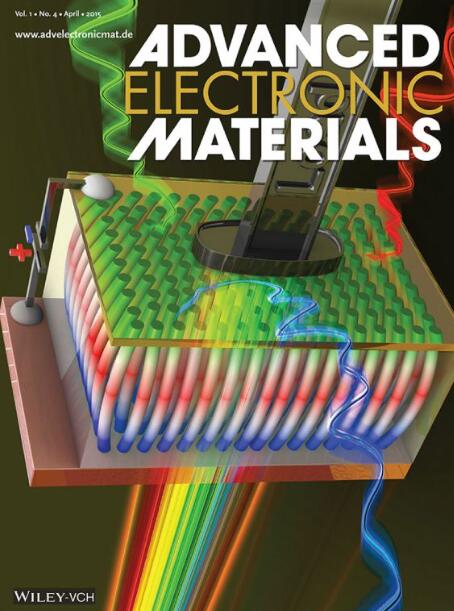Room-Temperature Blackbody-Sensitive Photodetector with Visible-To-Long-Wavelength-Infrared Photoresponse and Ultrafast Speed Based on a Te/PtSe2 Heterostructure
IF 5.3
2区 材料科学
Q2 MATERIALS SCIENCE, MULTIDISCIPLINARY
引用次数: 0
Abstract
Room-temperature blackbody-sensitive infrared photodetectors with ultra-broadband and ultrafast photoresponses are highly desired in numerous scientific and technical fields. However, it is challenging for an infrared photodetector to simultaneously possess all the aforementioned characteristics. In this study, a room-temperature Te/PtSe2 heterostructure photodetector is established to address this challenge, utilizing the built-in field of the heterostructure, the crossing conduction and valence bands of PtSe2, the high mobilities of both materials, and a considerable photogain. The device is photoresponsive over the ultrabroad wavelength range (519 nm–10 µm). The peak responsivity and specific detectivity reach 196.8 A W−1, and 4.3 × 109 cm Hz1/2 W−1, respectively, at the wavelength of 3.32 µm. The device also exhibits blackbody sensitivity, with a responsivity of 24.8 A W−1, and a specific detectivity of 7.4 × 108 cm Hz1/2 W−1. The photoresponse is ultrafast, corresponding to a 3 dB bandwidth of 160 kHz. The study provides new possibilities for high-performance room-temperature infrared detection.

基于 Te/PtSe2 异质结构、具有可见光-长波-红外光响应和超快速度的室温黑体敏感光电探测器
具有超宽带和超快光响应的室温黑体敏感红外光探测器是众多科学和技术领域所渴求的。然而,红外光探测器要同时具备上述所有特性是一项挑战。本研究利用异质结构的内置场、PtSe2 的交叉导带和价带、两种材料的高迁移率以及可观的光增益,建立了一种室温 Te/PtSe2 异质结构光电探测器来应对这一挑战。该器件在超宽波长范围(519 nm-10 µm)内具有光致响应性。在 3.32 µm 波长处,峰值响应率和比检测率分别达到 196.8 A W-1 和 4.3 × 109 cm Hz1/2 W-1。该器件还具有黑体灵敏度,响应率为 24.8 A W-1,比检测率为 7.4 × 108 cm Hz1/2 W-1。光响应速度极快,相当于 160 kHz 的 3 dB 带宽。这项研究为高性能室温红外探测提供了新的可能性。
本文章由计算机程序翻译,如有差异,请以英文原文为准。
求助全文
约1分钟内获得全文
求助全文
来源期刊

Advanced Electronic Materials
NANOSCIENCE & NANOTECHNOLOGYMATERIALS SCIE-MATERIALS SCIENCE, MULTIDISCIPLINARY
CiteScore
11.00
自引率
3.20%
发文量
433
期刊介绍:
Advanced Electronic Materials is an interdisciplinary forum for peer-reviewed, high-quality, high-impact research in the fields of materials science, physics, and engineering of electronic and magnetic materials. It includes research on physics and physical properties of electronic and magnetic materials, spintronics, electronics, device physics and engineering, micro- and nano-electromechanical systems, and organic electronics, in addition to fundamental research.
 求助内容:
求助内容: 应助结果提醒方式:
应助结果提醒方式:


